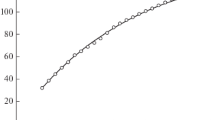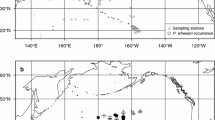Abstract
Samples were taken from a 2 900 m deep permanent station (centred on 54°40′N; 12°16′W) in the southern Rockall Trough, from November 1975 to September 1980, inclusive. Revision of juvenile size frequencies was necessary after removal of postlarvae of an annual non-viable settlement of Ophiocten gracilis (G. O. Sars) that were mistakenly included in a previous analysis. The present study of the revised data shows that settlement of Ophiura ljungmani (Lyman) occurs in summer when disk-size frequencies are dominated by the newly metamorphosed postlarvae. The likely age composition in larger sizes was suggested from the progression of modes along the size axis in juvenile size classes in consecutive were developed from Gaussian mixtures fitted by constrained computer search using, as starting values, component parameter values suggested from the frequency histograms. Choice between competing solutions was made on the basis both of goodness-of-fit and biological plausibility. However, identification of year-class structure amongst sizes >3 to 4 mm disk diameter remained conjectural owing to the low frequencies of adults in the samples. Comparison of the fitted component-means in the time series suggested a marked seasonal growth pattern, with maximal growth in spring. Probable age composition amongst adult sizes was extrapolated from von Bertalanffy growth parameters estimated from the means of juvenile year classes.
Similar content being viewed by others
Literature Cited
Bhattacharya, C. G.: A simple method of resolution of a distribution into Gaussian components. Biometrics 23, 115–135 (1967)
Bouchet, P.: Mise en évidence de stades larvaire planktoniques chez des gastéropodes prosobranches des étages bathyal et abyssal. Bull. Mus. natn. Hist., nat., Paris (Sect. Zool., fasc. 227) 400, 947–972 (1976)
Cassie, R. M.: Some uses of probability paper in the analysis of size frequency distributions. Aust. J. mar. Freshwat. Res. 5, 513–522 (1954)
Crisp, D. J.: Energy flow measurments. In: Methods for the study of marine benthos, pp 197–279. Ed. by N. A. Holme and A. D. McIntyre. Oxford: Blackwell Scientific Publications 1971 (IBP Handbook No. 16)
Deuser, W. G. and E. H. Ross: Seasonal changes in the flux of organic carbon to the deep Sargasso Sea. Nature, Lond 283, 364–365 (1980)
Gage, J. D., R. H. Lightfoot, M. Pearson and P. A. Tyler: An introduction to a sample time series of abyssal macrobenthos: methods and principle sources of variability. Oceanol. Acta 3, 168–176 (1980)
Gage, J. D. and P. A. Tyler: Growth and reproduction of the deep-sea brittle star Ophiomusium lymani Wyville Thomson. Oceanol. Acta (In press)
Gorzula, S. J.: A study of growth in the brittle-star Ophiocomina nigra. West. Nat. 6, 13–33 (1977)
Hasselblad, V.: Estimation of parameters for a mixture of normal distributions. Technometrics 8, 431–441 (1966)
Hessler, R. R. and H. L. Sanders: Faunal diversity in the deep-sea. Deep-Sea Res. 14, 65–78 (1967)
Knudsen, J.: The systematics and biology of abyssal and hadal bivalvia. Galathea Rep. 11, 7–236 (1970)
Lightfoot, R. H., P. A. Tyler and J. D. Gage: Seasonal reproduction in deep-sea bivalves and brittlestars. Deep-Sea Res. 26A, 967–973 (1979)
Lutz, R. A., O. Jablonski, D. C. Rhoads and R. D. Turner: Larval dispersal of a deep-sea hydrothermal vent bivalve from the Galápagos Rift. Mar. Biol. 57, 127–133 (1980)
Macdonald, P. D. M. and T. J. Pitcher: Age-groups from sizefrequency data: a versatile and efficient method of analyzing distribution mixtures. J. Fish. Res. Bd Can. 36, 987–1001 (1979)
McNew, R. W. and R. C. Summerfelt: Evaluation of a maximumlikelihood estimator for analysis of length-frequency distributions. Trans. Am. Fish. Soc. 107, 730–736 (1978)
Mileikovsky, S. A.: Types of larval development in marine bottom invertebrates, their distribution and ecological significance: a re-evaluation. Mar. Biol. 10, 193–213 (1971)
Morrison, G. W.: Studies on the ecology of the subantarctic ophiuroid Ophionotus hexactis (E. A. Smith), 213 pp, M. Phil. thesis, University of London 1979
Mortensen, T.: Handbook of the echinoderms of the British Isles, 471 pp. Oxford: University Press 1927
Nelder, J. A. and R. Mead: A simplex method for function minimisation. Comput. I. 7, 308–313 (1965)
Ockelmann, K. W.: Developmental types in marine bivalves and their distribution along the Atlantic coast of Europe. Proc. 1st Eur. malac. Congr. 1962, 23–35 (1965). (Ed. by L. R. Cox and J. F. Peake. London: Conchological Society of Great Britain and Ireland & Malacological Society of London)
Ricker, W. E.: Computation and interpretation of biological statistics of fish populations. Bull. Fish. Res. Bd Can. 191, 1–382 (1975)
Salzewadel, H.: Arm-regeneration in Amphiura filiformis (Ophiuroidea). Veröff. Inst. Meeresforch. Bremerh. 14, 161–167 (1974)
Scheltema, R. S.: Reproduction and disperasal of bottom dwelling deep-sea invertebrates: a speculative summary. In: Barobiology and the experimental biology of the deep sea, pp 177–186. Ed. by R. W. Brauer. Chapel Hill: University of North Carolina Press 1972
Schnute, J. and D. Fournier: A new approach to length-frequency analysis: growth structure. Can. J. Fish. aquat. Sciences 37, 1337–1351 (1980)
Schoener, A.: Post-larval development of five deep-sea ophiuroids. Deep-Sea Res. 14, 645–660 (1967)
Schoener, A.: Fecundity and possible mode of development of some deep-sea ophiuroids. Limnol. Oceanogr. 17, 193–199 (1972)
Sokal, R. R. and F. J. Rohlf: Biometry. The principles and practice of statistics in biological research, 776 pp. San Francisco: W. H. Freeman & Co. 1969
Thorson, G.: Reproduction and larval development of Danish marine bottom invertebrates. Meddr Kommn Danm. Fisk.-og Havunders. (Ser. Plankton) 4(1), 1–523 (1946)
Thorson, G.: Reproductive and larval ecology of marine bottom invertebrates. Biol. Rev. 25, 1–45 (1950)
Tyler, P. A. and J. D. Gage: Reproductive ecology of deep sea ophiuroids from the Rockall Trough. In: Cyclic phenomena in marine plants and animals, pp 215–222. Ed. by E. Naylor and R. G. Hartnoll. Oxford: Pergamon Press 1979
Tyler, P. A. and J. D. Gage: Reproduction and growth of the deep-sea brittlestar Ophiura ljungmani (Lyman). Oceanol. Acta 3, 177–185 (1980)
Walford, L. A.: A new graphic method of describing the growth of animals. Biol. Bull. mar. biol. Lab., Woods Hole 90, 141–147 (1946)
Author information
Authors and Affiliations
Additional information
Communicated by J. Mauchline, Oban
Rights and permissions
About this article
Cite this article
Gage, J.D., Tyler, P.A. Re-appraisal of age composition, growth and survivorship of the deep-sea brittle star Ophiura ljungmani from size structure in a sample time series from the Rockall Trough. Mar. Biol. 64, 163–172 (1981). https://doi.org/10.1007/BF00397105
Accepted:
Issue Date:
DOI: https://doi.org/10.1007/BF00397105




